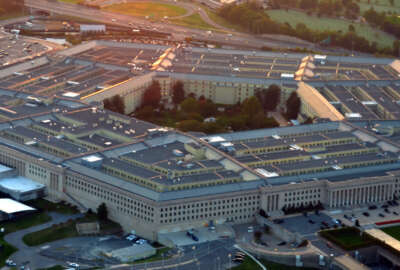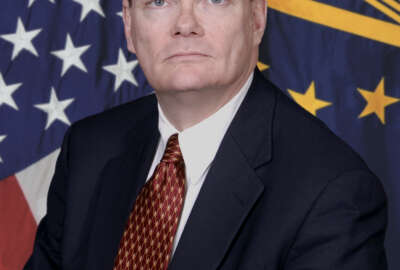
As CIO exits, DoD’s direction for IT has distinct commercial flavor
Terry Halvorsen retired Feb. 19 after spending the last two-plus years as the Department of Defense chief information officer.
During his two-plus years as the Department of Defense chief information officer, Terry Halvorsen didn’t shy away from big challenges or pronouncements.
Halvorsen, whose last day at the Pentagon was Feb. 17, sparked uproars about everything from moving off the Common Access Card to moving 90 percent of the DoD to Microsoft’s Windows 10. He set, what some would call, stretch or even unachievable goals and dared the services and military agencies to tell him why it wasn’t achievable.
While I never had the pleasure of attending a meeting with other military service or even federal CIOs where Halvorsen spoke, having been in several press conferences with him I could only imagine his patience for unsupported or long, drawn out reasonings was short.
From a media perspective, Halvorsen was always a fun interview. He was sharp, got to the answer quickly and didn’t have tolerance for reporters who asked a question and then asked it again. He told you as much as he could and wasn’t bashful in moving on from questions he was done with.
That is why Halvorsen’s final media roundtable was both a treat and an opportunity to understand where DoD is heading in the future.
“I broke a lot of stuff and, basically, he gets to clean it up,” Halvorsen said referring to John Zangardi, who will serve as acting CIO until Secretary James Mattis names a new one. “We are making good progress on some good things —Joint Regional Security Stacks (JRSS), Windows 10, cloud, which I prefer to call distributed computing, and the cyber scorecard. The big challenges for DoD are how do you keep up with the threat pace? Every time we make a gain in cybersecurity, the bad guys are working to counteract that. That’s not going to stop. We have to become more agile in that space, and I would argue in most spaces that we are in. That includes talking more about procurement and acquisition.”
The difference between procurement and acquisition is as simple as DoD needing to buy existing technology versus acquiring the skills to develop software on its own.
Halvorsen has been a huge proponent over the years of moving DoD toward procurement of IT.
Just take a look at the JRSS. It’s based on commercially available cybersecurity technology.
DoD’s move to Windows 10 is another example. It’s not a customized version of the operating system. It’s not a DoD-only version, but an effort that takes advantage of the security features Microsoft already provides, but most organizations do not turn on.
“[JRSS is] the first time we’ve done all this with completely off-the-shelf equipment. That’s a big culture change that I think will sustain,” he said. “Windows 10 is the foundation that lets us move to the cloud or distributed computing. If you don’t get Windows 10, and people will say other people have done it without moving to a single operating system, and I’ll ask you to go read how that went, and how long it took them. It’s really hard. And if you are talking about the complexity of the DoD, most people in industry would agree with this, it is the most complex enterprise IT, network structure in the world. So going to that single operating … we will be 90 percent Windows 10 … that makes sense for what we do. That lets us start moving at the speed industry can move.”
He said by making a large majority of the DoD work on a homogeneous network in terms of the operating system, similar to the leading-edge tech companies, will open the door to automated patching, to more commercial apps and a host of other benefits that currently aren’t available or at least aren’t easy to access.
“Part of what we have to do in DoD is really clarify when we are doing acquisition and when we are doing procurement. Most of the stuff in IT is going to be procurement,” he said.
JRSS and the Windows 10 migration are under a lot of pressure internally and externally. The services did not meet the deadline to move to Win10 by January 2017, and Congress is asking DoD to report on the effectiveness of JRSS before claiming full operational capability.
So Halvorsen has been on, what I’ll call, a bit of a publicity campaign over the last few months to ensure both military and civilian personnel and lawmakers understand the goals and potential benefits of both initiatives.
That’s why Halvorsen said he’s pleased Zangardi has agreed to step in during the interim. Zangardi’s background includes a healthy dose of acquisition and finance. Halvorsen said these are the two most important skills a CIO needs to have these days.
This push toward DoD buying more commercial IT also is coming from Congress. In the 2017 Defense authorization bill, lawmakers included numerous provisions to give the Pentagon the ability to change how it buys. For example, the law lets DoD set up a pilot to buy “innovative commercial items” for up to $100 million through open calls to industry to solve particular technological problems, rather than the traditional procurement process in which the department defines precise requirements in a formal request for proposals. Any items DoD buys after a peer review of industry proposals would be considered “commercial” for other procurement law purposes, and they’d be deemed to have been acquired in open competition.
Halvorsen said the move to commercial buying is as big of a culture change for DoD as the technology it is bringing in. He said the work the Pentagon’s digital services team, the Defense Innovation Unit-Experimental (DIUx), are helping to disrupt the culture and bring in commercial technologies.
“They can go in and spot work a specific problem, very fast and with great industry expertise,” he said. “For my mind, they need to be there and just the fact they are in the building, they are people who come from Silicon Valley or the high-tech area and they challenge some of our business and process assumptions, and we need to be constantly challenged on some of that.”
As for what’s next, Halvorsen said he wasn’t sure, but said he would stay in the federal community.
Halvorsen’s impact on DoD is clear, and while he was far from perfect — see his data center consolidation effort and much-maligned idea to move off the Common Access Card — he brought the right tone and tenure to the Pentagon.
Return to the Reporter’s Notebook
Copyright © 2025 Federal News Network. All rights reserved. This website is not intended for users located within the European Economic Area.
Jason Miller is executive editor of Federal News Network and directs news coverage on the people, policy and programs of the federal government.
Follow @jmillerWFED
Related Stories







